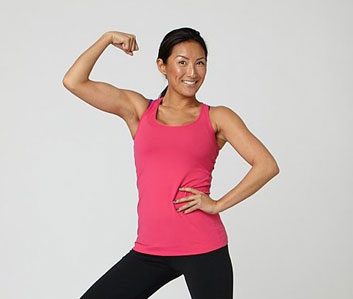
Meet Tanya Kim
Tanya Kim, anchor of CTV entertainment show etalk, could use many excuses to skip exercise, especially her insane hours-including covering the Oscars in L.A. at the end of February. But the 30-something Kim loves her Pilates. And as you can see from the photos, it’s a great way to stay toned. “When I took it up three years ago I was looking for an exercise that’s not too heavy-duty, but not too calm. I love it.”
Says her instructor, Anita Ivic, owner of Imprint Pilates in Toronto, “Pilates boosts core strength, adds flexibility, strengthens and straightens the spine, and helps posture.”
Here, Kim shows her stuff with our custom workout. If you’re in good shape, this shouldn’t be too hard, but we have included easier options. Regardless, take it slow, and consider speaking to your doctor first.
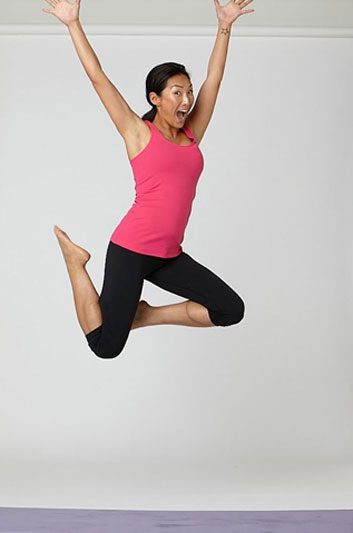
Get Started
All you need are comfy clothes and a mat. Ivic says it could help to have a wall mirror in the workout area so you can check posture and positioning. “Most importantly, if you feel any of the exercises straining your lower back, you’re doing something wrong and you need to modify the workout.” All exercises can be adjusted for beginners or those with injuries.
Breathing: Breathing is central to Pilates. ?As part of the warm-up, start by lying on your back, inhaling through the nose and doing a forced exhale through the mouth. “The forced exhale helps connect the lower abs,” says Ivic.
Spine position: In Pilates, “we focus on stabilizing before moving,” says Ivic. “You have to get that connection of the lower abdominal muscles stable and strong before moving.” To do this, practise pelvic placement. There are two spine positions: imprint and neutral. As a warm-up, switch between them several times:
• The “imprint” position Lie on your back with your knees bent and feet on the floor. Engage your abs by drawing your ribs toward your hips and pulling your navel ?into your spine, slightly tipping your pelvis upward. “This should form an impression ?of your spine on the mat,” says Ivic.
• The “neutral” position Revert your spine to its natural curve, in which there is a gap between your back and the floor.
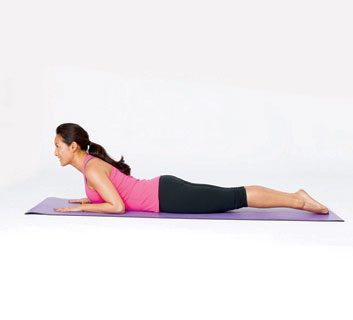
1. Breast Stroke
Targets: Erector spinae, upper back, inner thighs
- Start by lying on your stomach with your legs together and your forehead on the mat with neck in a neutral position to spine. Your arms should be in ?a “W” formation with elbows bent and hands at shoulder height.
- Pull your navel toward the spine, pelvic bones heavy in the mat, lowering ribs.
- Inhale and lift your upper body off the floor, keeping your forearms and palms flat on the floor (shown). Exhale and reach arms straight in front of you in the air.
- Inhale, bring your arms back to sides, then exhale and lower your upper body and head to floor. Keep your leg muscles drawing in toward each other and feet together, to engage inner thighs. Do 10 repetitions.
Beginners: “If you are feeling this in your lower back, you should separate your legs hip distance apart,” says Ivic.
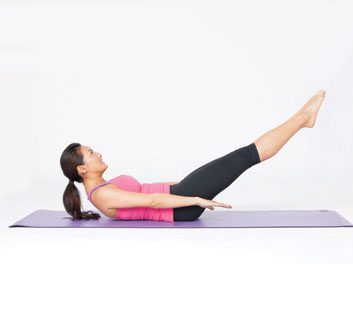
2. Hundreds
Targets: Rectus abdominis, obliques and hip flexors
- Lie on back, knees bent. Go to imprint position, inhale, then lift one leg up to tabletop position (shin parallel with floor), followed by the other.
- Exhale, and bring your head up, with chin down, gazing at your navel, curling upper spine off the floor.
- Inhale, and as you exhale, extend your arms, palms down. (Advanced option, pictured: Extend legs to a V.)
- Using a staccato breath, breathe in for five short breaths, pumping arms up and down, then breathe out for five short breaths. With each breath set, tighten up the abs.
- Do 10 sets each of five breaths in, five out (for 100).
- (If in advanced V position, bring legs into tabletop.) Exhale, and roll your upper spine and head back to the floor. Put one leg down, then the other.
Beginners: Both feet can stay on the mat.
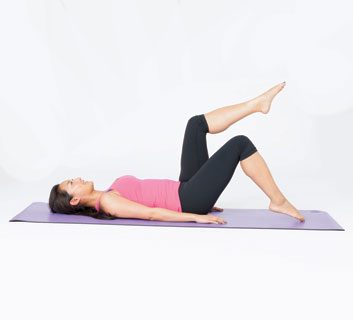
3. Toe Taps
Targets: Rectus abdominis, hip flexors
- Lie on your back with your knees bent, feet on floor. Go to imprint position.
- Inhale, and lift your left leg to tabletop position. Exhale, and lift right leg. Inhale, holding legs at tabletop.
- Exhaling, slowly lower your right leg down, tapping your foot on the floor 10 times (shown). Inhale and bring it back to tabletop. Repeat with the left leg, alternating each leg 10 times.
Beginners: Keep one foot on the floor, and do the toe taps with the other leg, 10 repetitions, then switch sides.
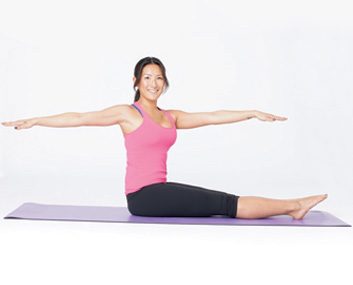
4. Spine Twist
Targets: Obliques, upper back, rhomboids, upper trapezius, posterior and anterior deltoids, hamstrings
- Sit with legs in front of you, tall through the spine, feet flexed.
- Inhale, then exhale to pull in abs, pulling navel toward spine.
- Inhale, and take arms out to the sides, facing forward and keeping shoulders relaxed and ribs pulling down.
- Exhale, rotating body to the right and extending left arm toward feet (shown).
- Inhale back to centre, with arms at sides. Switch sides and repeat 10 times.
Beginners: Sit cross-legged (not with legs stretched in front of you).
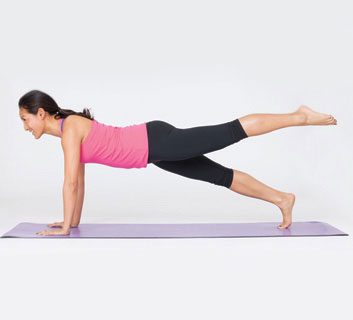
5. Leg Pull Front
Targets: Rectus abdominis, iliopsoas, pectorals, triceps, glutes
- Start on all fours, palms in line with shoulders. Pull navel into the spine.
- To move into plank position, extend one leg back, with bottoms of toes on the mat, knee off the mat. Then bring the other leg back to meet it; either keep legs and feet together, or keep them at hip width if it’s too challenging to stabilize your hips.
- Inhale and, as you exhale, lift your left leg behind you from the hip, keeping hips still (shown). “The key is to engage through your abdominals, and keep your body in a stable plank position,” says Ivic. “You don’t want to sway in the back. You want to feel like the leg is reaching straight back, and you’re stretching from your toes to the top of your head.”
- d. Inhale while returning foot to the floor. Switch sides, repeating five times for each leg.
Beginners: Start on all fours. Keep one knee on the floor and extend the other leg back and up; hold for 10 seconds. Switch legs. Do each leg 10 times. Or do 10 leg lifts, one leg at a time. Maintain a stable, straight spine.
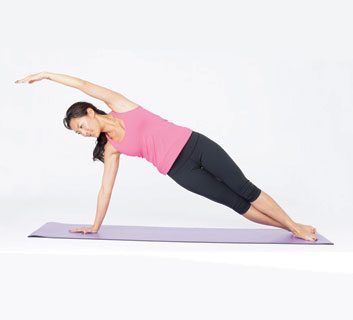
6. Side Bend
Targets: Obliques, pectorals, arms
- Sit with left knee bent, left foot flat on the mat two to three feet (60-90 cm) out from you (the closer the foot, the harder the exercise). Right foot should be on the floor tucked behind the left ankle. Place right hand flat on the floor one foot (30 cm) away from your right hip, preparing to support the upper-body weight.
- Inhale and, as you exhale, ?lift your hips off the mat as you extend both legs fully-without pushing your feet out-drawing inner thighs toward one another to a side plank. Your right leg is slightly behind the left, with only your feet and right hand touching the floor. Keep exhaling while extending your left arm overhead (shown). “This is a beautiful movement that looks like a rainbow,” says Ivic. “There is a lot of work happening in that supporting arm.”
- Slowly lower to the mat, and repeat five times; switch sides.
Beginners: Keep the right knee on the mat as you lift your hips and extend left arm overhead. Slowly lower hips back to the mat, and repeat five times before switching sides.
Related:
• What the shape of your spine says abou you
• How to choose the best yoga mat
• Yoga for beginners
